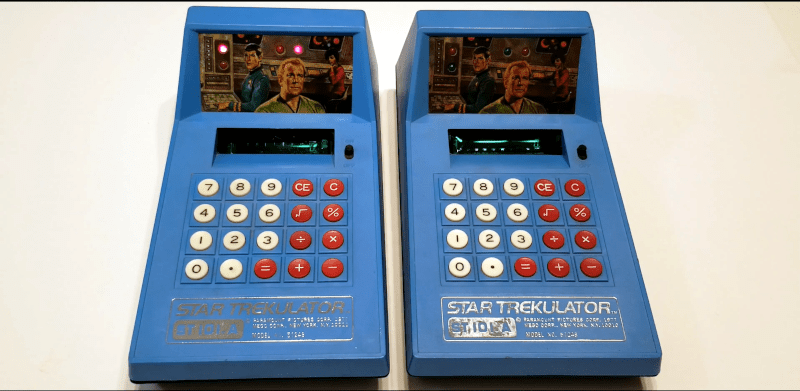Back in 1976, when calculators were not common or cheap, a company named MEGO made the Star Trekulator: a calculator sporting a Star Trek theme. However, it was a bit odd since the calculator didn’t correspond to anything you ever saw on the TV show. It was essentially a very simple calculator with a Star Trek picture and some blinking LEDs. [Computer History Archives Project] has two examples of the rare calculator and shows them off, including the insides, in the video below. We’ve also included a vintage commercial for the device a little farther down.
Inside the 5-inch by 9.5-inch cabinet was an unremarkable printed circuit board. The main component was a TI calculator chip, but there were a surprising amount of other components, including three that [Computer History Archives Project] could not identify.
MEGO was known for making Star Trek toys, including a cassette player that (sorta) looked like a tricorder and communicator walkie-talkies. We wish they’d made the calculator look like some sort of prop from the show, although the beeping noises, we suppose, were supposed to sound like the Star Trek computers.
Honestly, we want to 3D print a case to replicate this with modern insides that can drive a display to put different Trek clips and sound effects out. Now, that would be something. Maybe [Michael Gardi] can take a look at it when he’s got a spare minute. If anything, the calculator looks too advanced to be on the original series. They should have gone VFD. Although Mr. Spock has been seen with a flight slide rule (an E6-B, if we recall). We prefer our props to look like the real ones, thank you.















“They should have gone VFD.”
It *does* use a VFD — plainly visible, espepcially around 6:15 in the video.
Kinda surprised C.H.A.P. can’t identify an inductor or a resistor array package. Pretty common components, especially from that era.
AI narration though… ouch.
The remark about the wires in the device made me laugh, this kind of wiring methods isn’t strange for anything over 40 years old and as long as you don’t wiggle parts/wires around too much it can be pretty durable, chances are that the broken wire in the video didn’t break until it was opened to make the video.
The remark about the speaker being removed “probably to repair another unit” made me laugh, speaking as a parent I can confirm that any device with a speaker can become pretty annoying pretty quickly. So I would not be surprised if the speaker was removed by an angry mom or dad decades ago.
The video mentioned “plastic screws” and “aluminum screws”, which was new to me. I’ve disassembled pretty much shit over the past 5 decades, but I’ve only noticed screws that rust or clips that break. And ohh… a not so rusty screw safely hidden from the elements underneath a label. Aluminum screws could have past my screwdriver, but I just never identified them as such, so I guess I did learn something today. Besides, the video showed a nice piece of retro hardware, which is always fun to see.
“aluminum” (non-magnetic metallic) screws are almost certainly not aluminum. Much more likely die cast white metal/pot metal/zinc alloy/Zamak/Mazak
I agree with what you wrote. However, the young Youtuber isn’t wrong, either.
Objectively speaking the cable managment, the wiring, was poorly done. Soldering, too.
It’s just that it was common practice in that era.
Probably it was all done by a dozen poor workers on the assembly line.
Radio alarm clocks and cassette recorders from the 70s were built similar. Using cheap PCB material, too.
Higher‐end appliances and devices of same era had proper wiring, though.
On the bright side, the devices featured modular designs and screws.
They weren’t glued yet or had holding clips made of plastic.
Thanks for the callout Al. This is definitely something I will look into.
What was the TMS8055 microcontroller?
Check the datamath dot org web site. TMS0855 was dedicated calculator chip from the mid-1970s. (successor to theTMS0100 family from the early-1970s). Within the TMS085x family, the 0855 included the Square Root function.
No thanks, I’ll keep it old school like Spock.
https://aviation.stackexchange.com/questions/104778/which-aviation-flight-computer-is-spock-using-aboard-the-enterprise-as-a-prop
More
https://www.trekbbs.com/threads/props-re-used.81174/page-7
He had a Cracker Jack Blue Decoder disk too—like this
https://www.etsy.com/market/cipher_decoder
The TDK component is another transformer, high voltage for the VFD.